Rome is one of the most beautiful cities in the world, no one can doubt that. Every time I look into it, I’m struck again by what a cool city it is.
In this guide I will share with you Rome, Italy: 27 Best Things to Do and See. You can easily get around on foot, you can easily and quickly get to the city center from the airport, and you’ll find so many excellent restaurants in the city that you won’t be able to try them all in a single visit. This 2,500-year-old city manages to amaze me with every visit, and I believe you’ll fall in love with it too. Let’s take a look together at tips on what to see in Rome.

How to get in Rome from the airport to the centre
Rome has two international airports, Leonardo da Vinci (Fiumincino) and the smaller Ciampino. Most flights from the Czech Republic arrive in Fiuminicino, from where you can easily reach Rome by train or bus. The train costs 13 euros and the bus costs 7 euros. You can also take a taxi, but expect to pay at least 50 euros.
Rome: where to Stay?
In Rome, it’s definitely worth staying in the centre, ideally close to the main station where the train from the airport stops or one of the bus stops from the airport. Rome is easy to get around on foot and public transport (although it has improved in recent years) is slow and, according to locals, unreliable.
We stayed at the Residenza Cavallini, which is five minutes from the airport bus express stop, a short walk from the Vatican and the Trevi Fountain. The accommodation was clean, the rooms were small, but breakfast was included in the price at a nearby cafe (croissant, toast and cappuccino – what more could you ask for?).
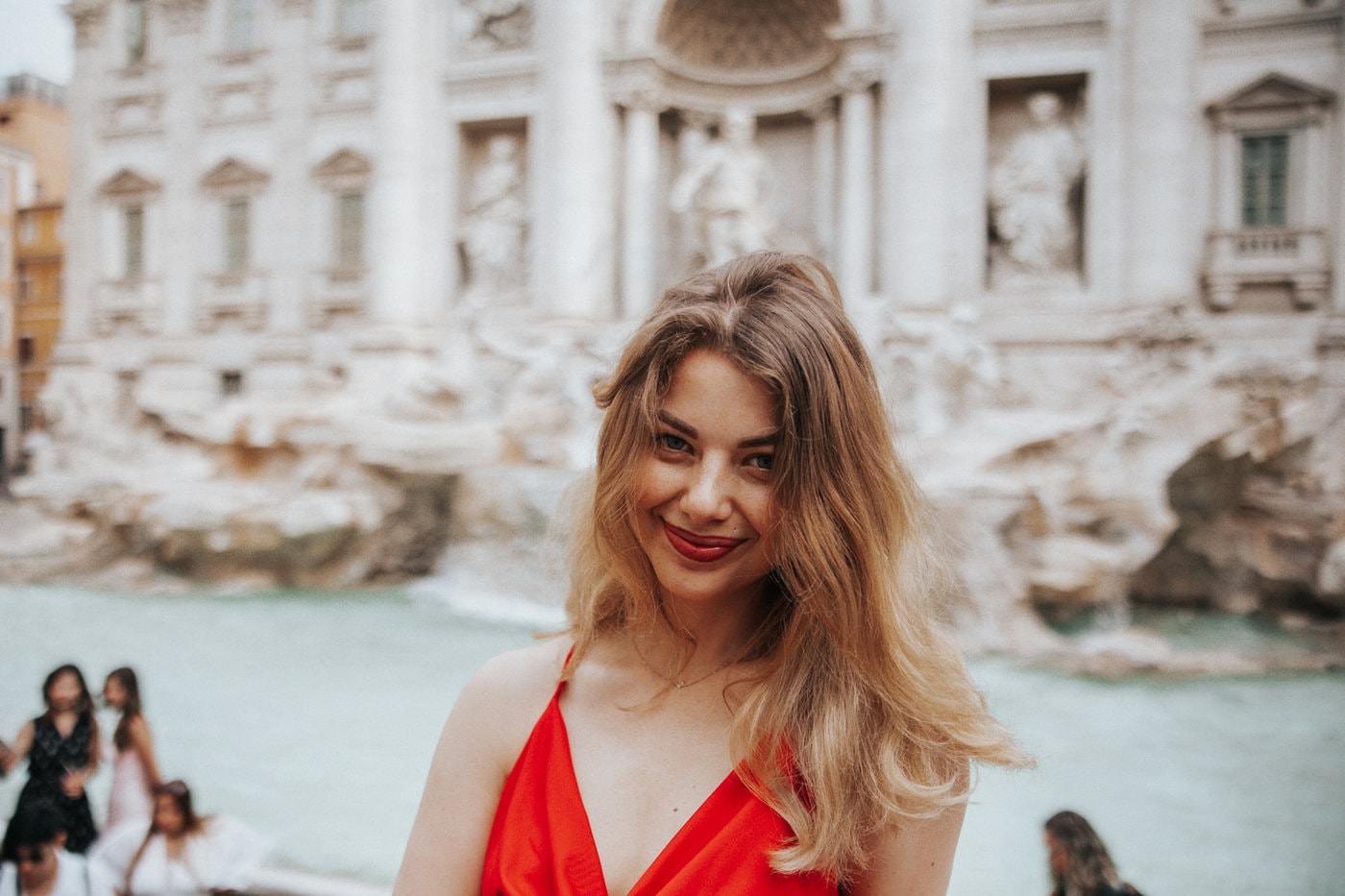
How to get around Rome?
The best way to get around is on foot, as I mentioned above, public transport is slow and often unreliable, although it has improved significantly in recent years. If you want, you can try local electric bikes or electric scooters. We borrowed them once when we were tired after walking in 30 degrees all day.
Usually, you don’t have to worry about anything happening to the e-scooter, but for peace of mind, it’s worth checking if the rental company includes e-scooter insurance. This will ensure coverage in unexpected situations.
ROME WEATHERHow long to go to Rome for?
A spring or autumn long weekend is absolutely perfect for a visit to Rome. If you’re not an avid visitor to museums and galleries, you can easily do Rome in a weekend. For us, 3-4 days is ideal, but you can definitely do the most important things in one full day, you just have to walk a lot. Everything is relatively close, but we still walked 20-35 thousand steps every day and spent four days in Rome on our last trip.
How to Find the Cheapest Flights to Rome?
At the moment it is cheapest to fly with Ryanair, I recommend flying with carry-on only for the weekend. In Rome, the weather is beautiful from spring to autumn, so all I needed was two light dresses, CC cream, sunscreen and a camera.
Where to eat in Rome?
If you like Italian cuisine, you won’t go hungry in Rome. You can try one of the restaurants below
- PizzaRé – although it is a relatively remote pizzeria that does not impress you at first glance, their pizzas are first class. And at great prices.
- Alto Cocktail Bar – a newly opened very luxurious cocktail bar with a beautiful view and you can watch the sunset. Just count on high prices.
- Piccolo Buco – If you prefer Neapolitan-style pizza, make a reservation at Piccolo Buco.
- Pasta In Corso – Need a quick, good but cheap meal? Go for a great pasta at Pasta In Corso.
Other tips that you sent me but we didn’t manage to try: Bibliothé , al42 by Pasta Chef , Ginger , Giulia Restaurant , SantoPalato , Altroove Ristorante .
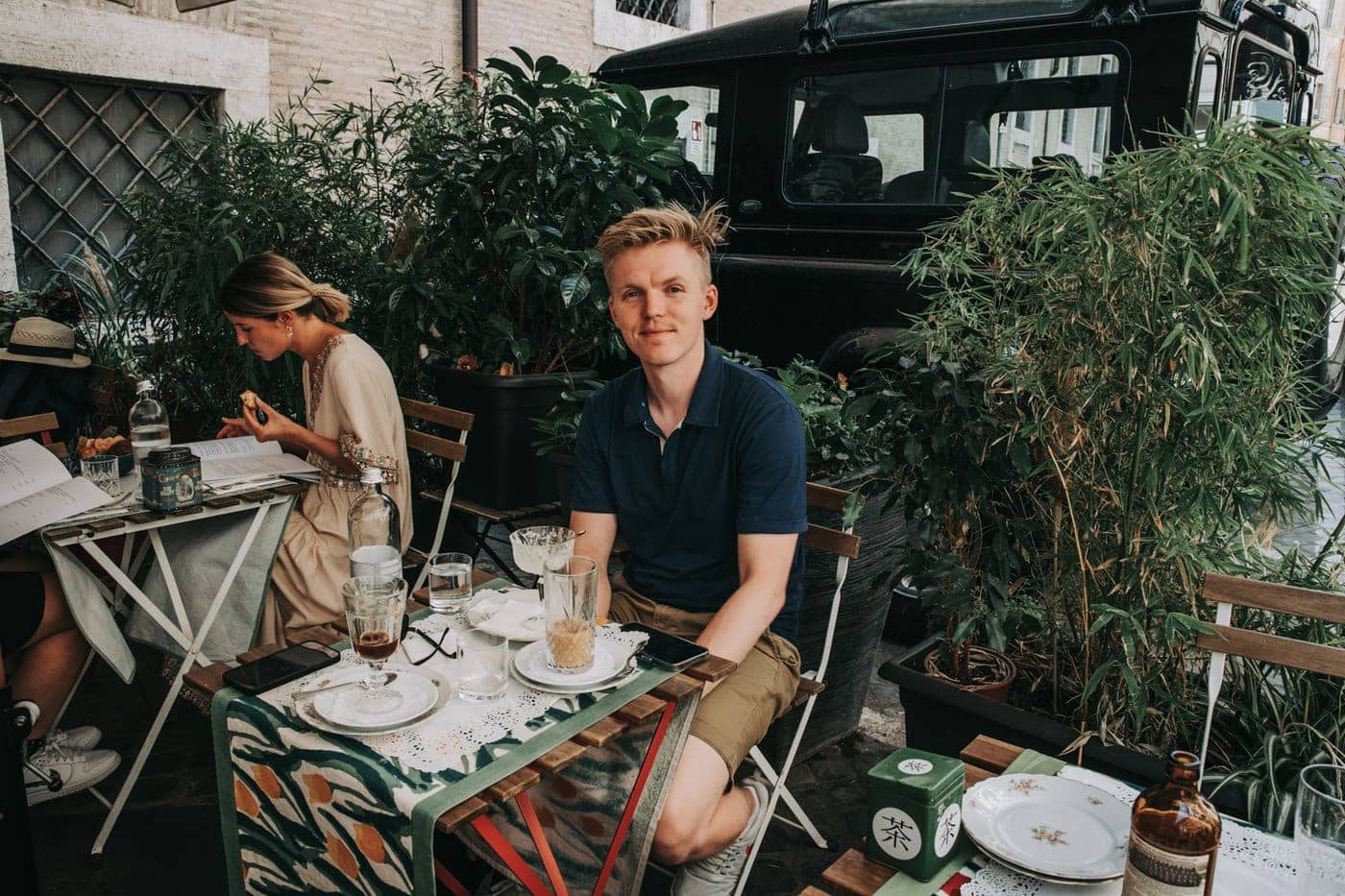
Is it worth buying tickets in advance and online?
It certainly does. Thanks to tickets purchased online, we were able to skip the queue at the Vatican, where one usually waits for hours without a ticket. Tickets for all the sights and attractions can be purchased at Getyourguide.com, which has the widest range of tickets.
If you’re not into skip-the-line tickets, you can stand the lines. However, for the Vatican at least, we strongly recommend purchasing tickets in advance. You’ll get tickets for a specific time slot and avoid queues where you might have to stand for several hours in direct sunlight with no shade.
How to save in Rome
Rome is truly beautiful and worth multiple visits, but it can also be quite expensive. Nevertheless, there are many ways to save money in Rome.
Start by purchasing the Roma Pass (available on GetYourGuide), which grants you access to selected attractions and unlimited use of public transport. And many Roman landmarks, such as the Pantheon (free for EU citizens under 18) or the Trevi Fountain, can be admired without paying any entrance fee.
Restaurants near tourist attractions tend to be more expensive, so look for less conspicuous trattorias where locals dine. Lunch menus (menù turistico) often offer great value for money. Use public drinking fountains (nasoni) instead of buying bottled water and avoid expensive taxi services – walking or public transport are not only cheaper but also more practical. Finally, we would recommend trying to plan your visit to Rome for the first Sunday of the month, when admission to state museums and monuments is free.
Where’s the sunset?
Ask any Roman where they go to watch the sunset, and Passeggiata del Gianicolo will top the list.
But it’s not the only great spot, the terrace on Pincian Hill, located on the opposite side of town from Gianicolo, is another amazing sunset option.
If you’re willing to work up a sweat in search of the perfect sunset shot and have comfortable walking shoes, head to the top of Monte Mario in the northwestern part of Rome.
If you would like to take a picture of the Basilica of St. Peter, you have to go to the Giardino degli Aranci at the top of the Roman hill of Aventine.
Where to go first thing in the morning?
First, it’s worth visiting the Trevi Fountain, which gets crowded early, the Colosseum , and the Vatican.
What to remember to take to Rome?
- Sunscreen.
- Comfortable shoes.
- Patches for any blisters from shoes.
- Insurance.
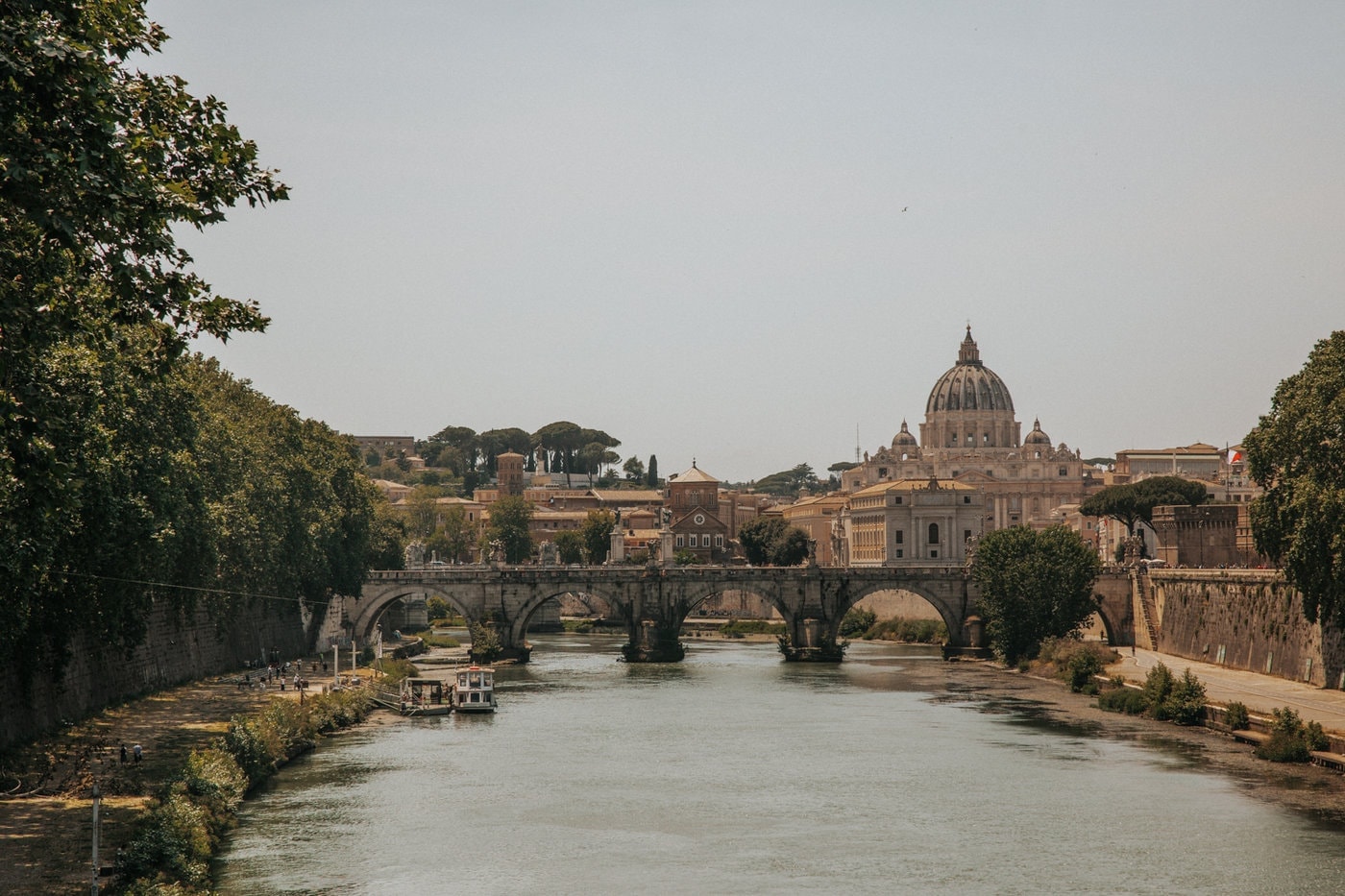
27 Places to Visit in Rome
It is said that all roads lead to Rome, and in ancient times, indeed, all roads radiated from this magnificent capital.
Cultural monuments from different periods are often linked in Rome. The pagan mausoleum is also a papal fortress and the medieval church has a Baroque façade. What should you not miss in the city?
Trevi Fountain
The Trevi Fountain should be your first point of interest as it fills up quickly with tourists, so it is advisable to visit it first thing in the morning. The magnificence of this fountain is breathtaking, I am always surprised by its majesty.
Although I am not a big fan of the Baroque, this gem by Nicola Salvi is bound to enchant anyone. It was built in 18. century and compared to the small square on which it stands, it looks like a huge stage. If you are a fan of older films, you may remember it from the movie La Dolce Vita (The Sweet Life, Frederico Fellini), where children frolicked in the fountain.
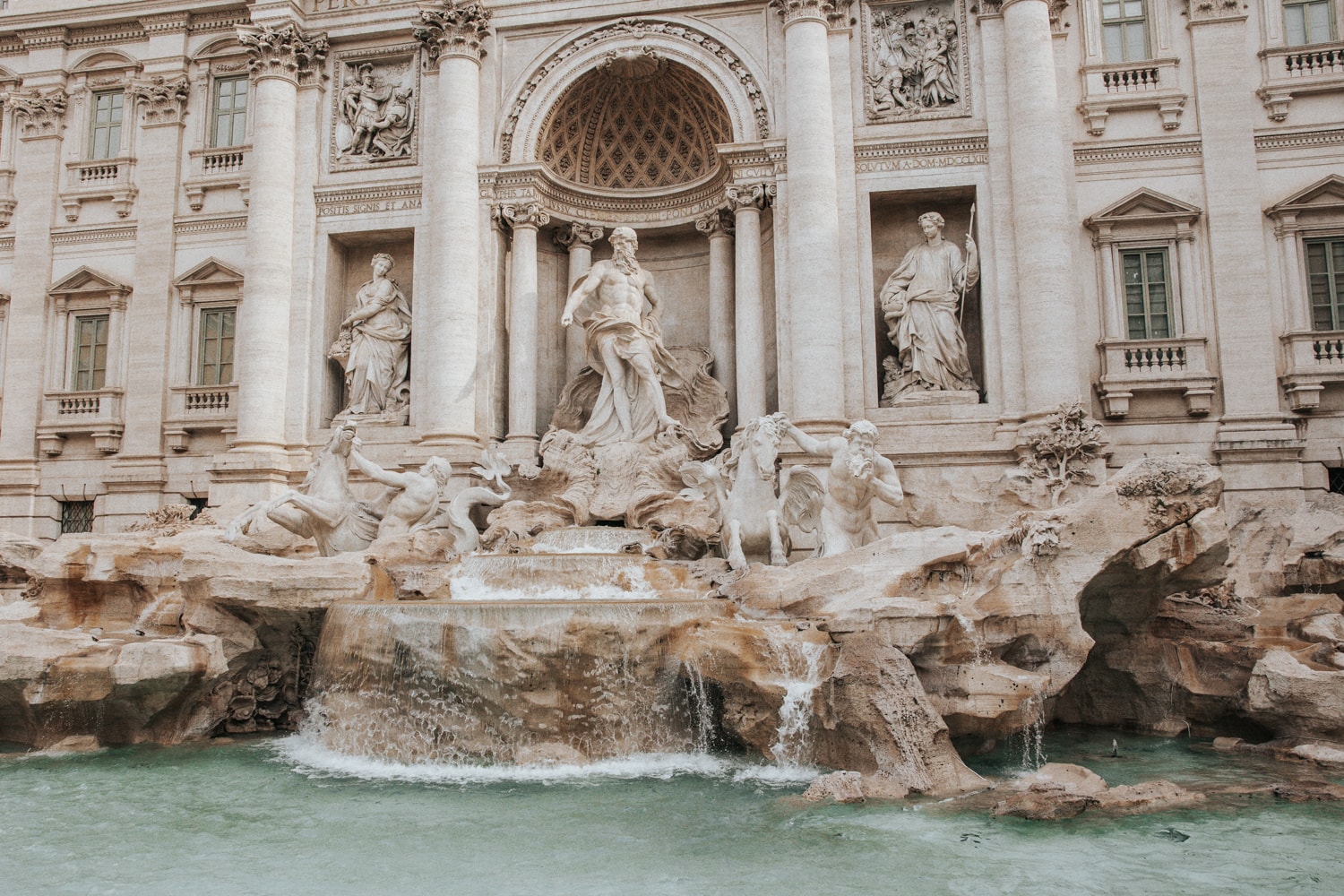
Roman Forum – Forum Romanum
I recommend visiting in the morning to avoid the midday sun, which can make your visit unpleasant. Here you can imagine the hustle and bustle of a great imperial city at its greatest glory.
The swampy area of the Forum, surrounded by the hills of the Palatine, Capitoline and Esquiline, used to be a commercial centre and the pride of the Roman metropolis with its white marble temples and golden roofs. After the invasion of the barbarians, however, it was completely filled in and only in the 19th century. century were uncovered by the excavation of a number of ancient buildings.
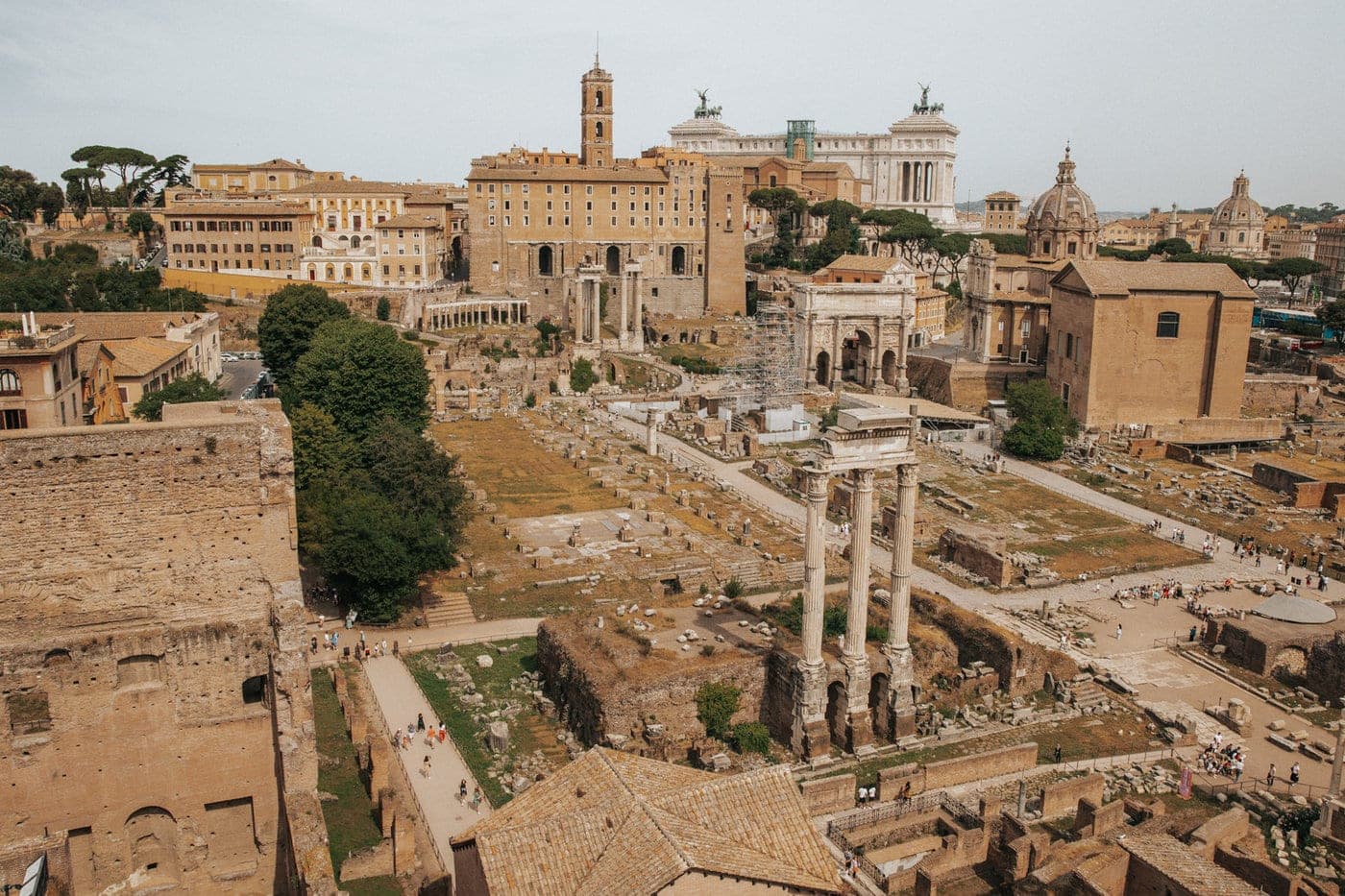
On the spot we learned that tickets can only be purchased online at . Only if you don’t have a phone, you can buy them on the spot.
Please note, the online offer includes the option to either send the ticket home or pick it up on the spot. The pick up button didn’t work, so we were advised to choose send home and the tickets should arrive.
We didn’t get anything in the mail, so we had to go to the kiosk anyway. But it’s all sorted out. Shopping through intermediaries such as GetYourGuide works much better.
Palatine
It is listed in the tips on what to see, separately, which can be confusing as it is included in the Forum Romanum ticket. It is the most important of the Seven Roman hills, where the original settlement of Rome began 1,000 years BC and from here the city gradually grew to its present form.
The Palatine Hill is considered an archaeological jewel because of the large number of remains of ancient buildings, public spaces and sports grounds, and is the best preserved of all the hills after the Capitol.
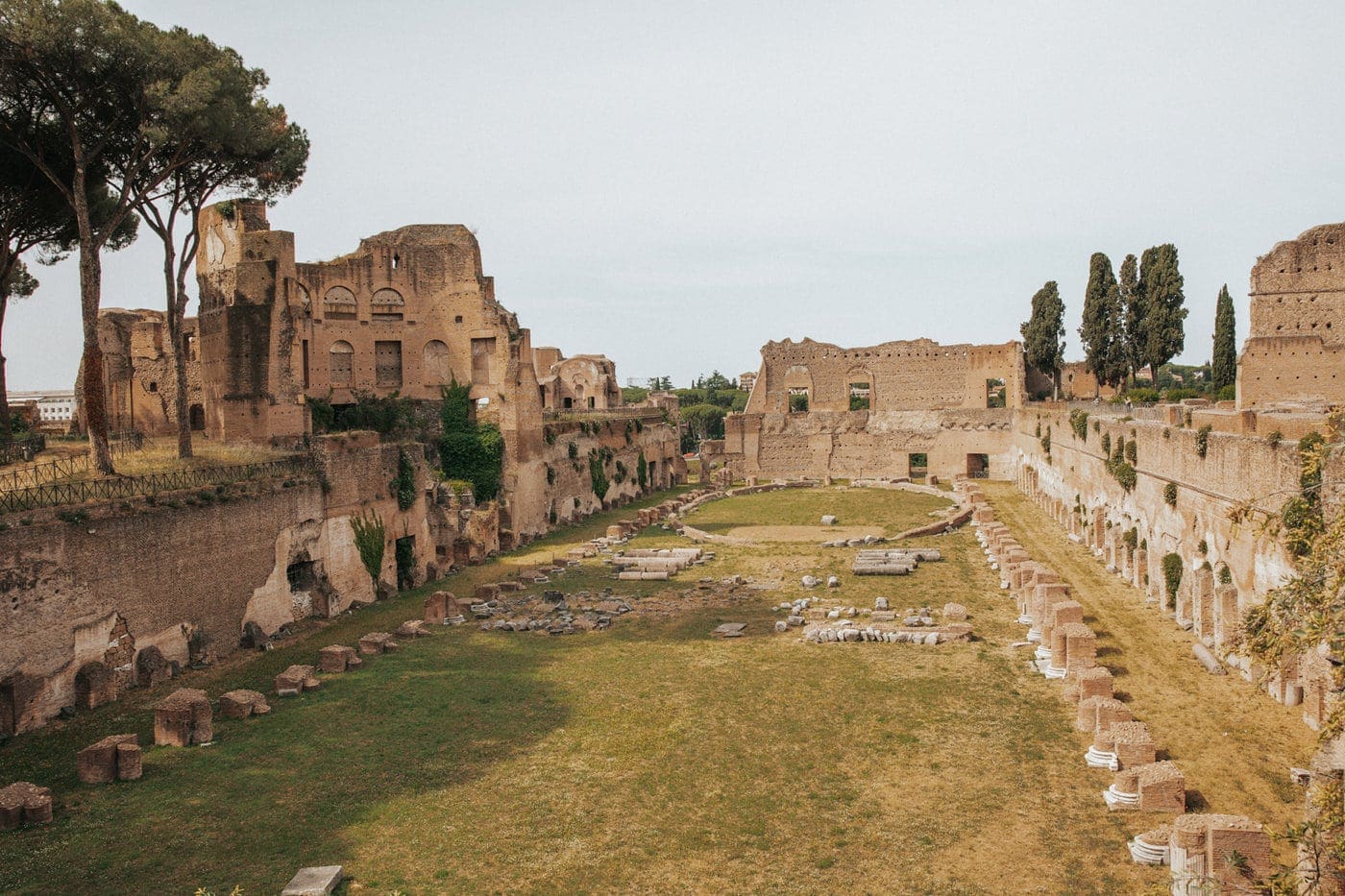
Colosseum
The Colosseum (Colosseo) is probably the most characteristic building in Rome, although I must admit that it’s not that interesting to me. But you won’t want to miss it, and frankly you can’t miss it if you visit the Forum Romanum.
The elliptical four-storey amphitheatre was built between 72 and 80 AD and can accommodate up to 50,000 spectators.
Tickets can only be purchased online . Again, beware, you can only choose to send the ticket home or pick it up on the spot on the website.

Piazza Venezia
Most people start their tour here, because the main traffic arteries converge here and there are bus stops.
The dominant feature of the square is the monument to Victor Emmanuel (Vittoriano); locals have a number of unflattering nicknames for the monument, such as “wedding cake” or “false teeth of Rome”. However, the monument provides one of the best views of the city, so if you have time, you can take the elevator up to the viewpoint.
The surrounding buildings are much more interesting, for example the Palazzo Venezia was Rome’s first great Renaissance palace and in the 20th century it was the first of the great Renaissance palaces. century, it served as the headquarters of Mussolini’s Guard. Currently there is a museum of medieval and Renaissance furniture, weapons, tapestries and ceramics.
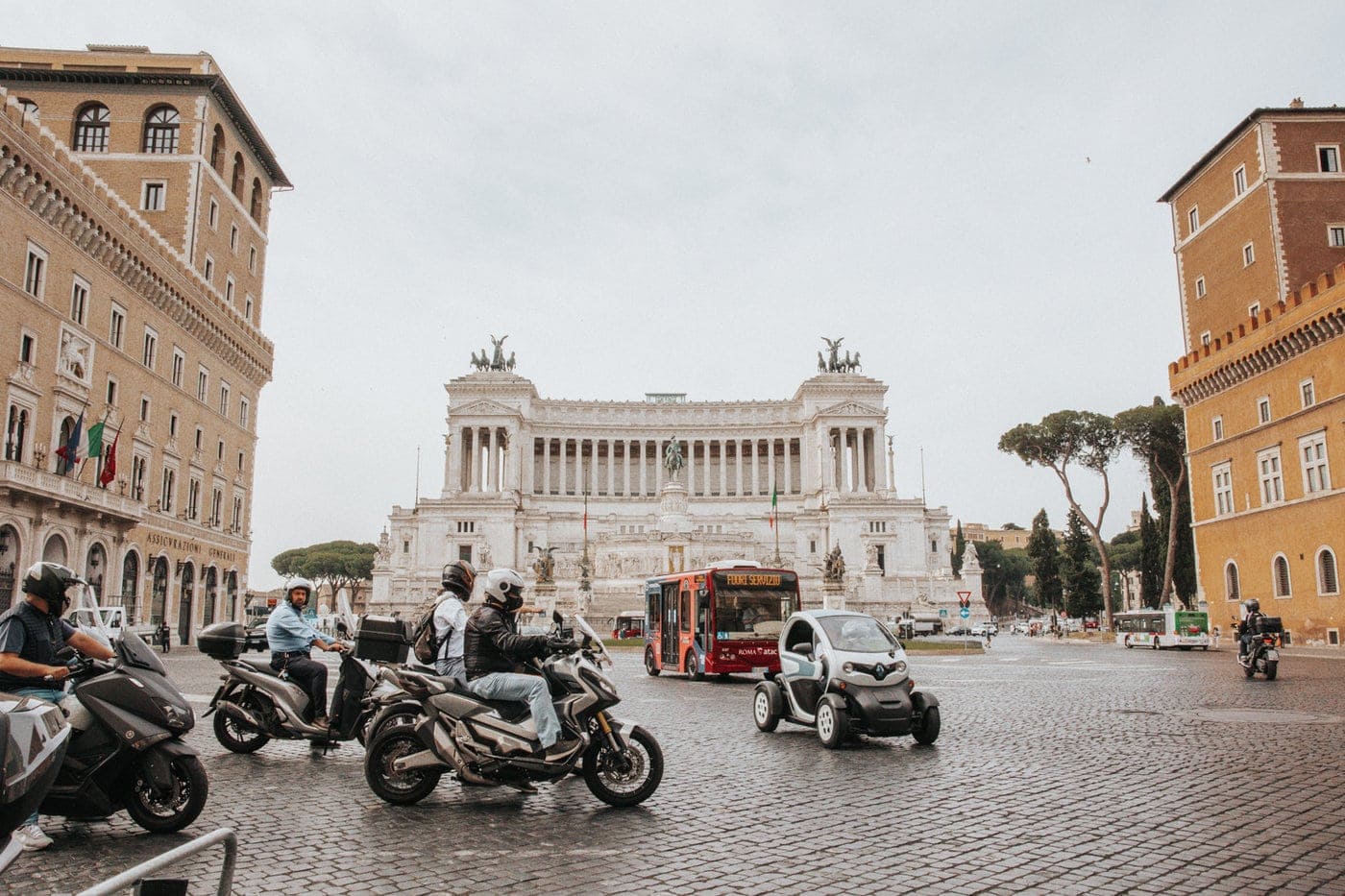
Pantheon
One of my strongest childhood memories of Rome is associated with the Pantheon. I remember we were walking through the narrow streets and suddenly we came out and in front of us was the huge structure of the Pantheon.
The Pantheon is truly magnificent, located in Piazza della Rotonda and admission is free. Don’t expect anything interesting inside, but be sure to enter. It is only when you enter it and look up that you realise the massiveness of the whole structure.
Originally built by Marcus Agrippa in 27 AD, the Pantheon was destroyed by fire and rebuilt by Emperor Hadrian in 125 AD. V 7. century was converted into a church.
In the past, the Pantheon was home to statues of the gods of Olympus, but nowadays you won’t find them inside. However, you will find the Renaissance tombs of the sculptor Raffaello and the architect Baldassare Peruzzi. There are also the remains of the first Italian king.

Piazza Navona
From the Pantheon, you can head straight to Piazza Navona, a place of rest and relaxation since 79. The Emperor Domitian had the athletic arena Circus Agonalis built here, giving the square an oval shape. In the Middle Ages, tournaments were held here and from the 17th century onwards. to 19. century, the square was the site of spectacular water festivals.
Fontana dei Quattro Fiumi – Fountain of the Four Rivers
The Fountain of the Four Rivers is located in Piazza Navona. It was designed by the Italian Baroque sculptor Gian Lorenzo Bernini. His technical versatility, compositional inventiveness and amazing skill with marble ensured that he was considered a worthy successor to Michelangelo and far surpassed other sculptors of his generation.
He was able to perfectly integrate his works into the environment in which they were located. His ability to synthesize sculpture, painting and architecture into a coherent conceptual and visual whole was described by the late art historian Irving Lavin as “the unity of the visual arts”.
But back to the Fountain of the Four Rivers. It symbolizes the great rivers of the four continents: the Americas (Rio de la Plata), Europe (Danube), Asia (Ganges) and Africa (Nile). Try to walk around it and see which statue belongs to which continent. A little hint: Bernini’s frequent disdain for other artists led to the claim that the god of the Nile was covering his head so he wouldn’t have to look at Borromini’s Church of Sant’Agnese in Agone, and the river god of America was going to capture the church in case it collapsed. It’s really just a joke, the church was actually built after the completion of the Fountain of the Four Rivers.
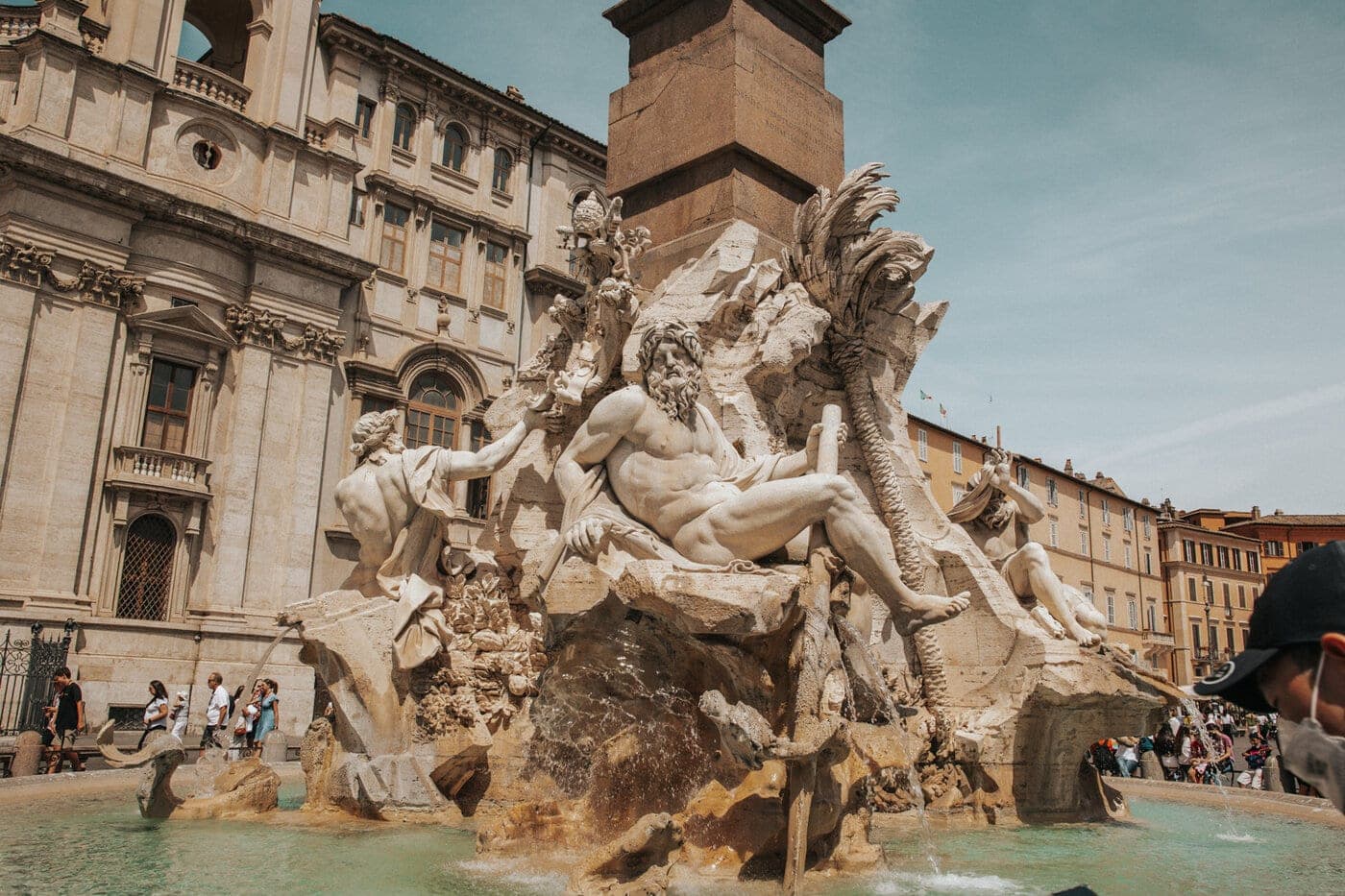
Market on Campo de Fiori
V 17. century, public executions took place here, and today it is a place where you can find markets with fruit, vegetables and flowers. It is said to be one of the most authentic places in Rome. We stumbled upon it just when we needed to freshen up. And nothing refreshes on a hot, steamy day like sliced melon chunks. It was just a bit too little for our taste at three euros.
Jewish Ghetto
From Campo de Fiori you can head southeast towards the former Jewish quarter. Today there are restaurants offering distinctive Roman-Jewish cuisine. There is also the Turtle Fountain (Fontana delle Tartarughe) from the 16th century. century, located in Piazza Mattei. It depicts young men lifting turtles up to a marble slab.
Spanish Steps
If you love Holiday in Rome with Audrey Hepburn, you’ll definitely want to sit on the Spanish Steps. Don’t do that. As of 2019, the penalty for this is a fine of between €160 and €400, or between CZK 4,100 and CZK 10,300.
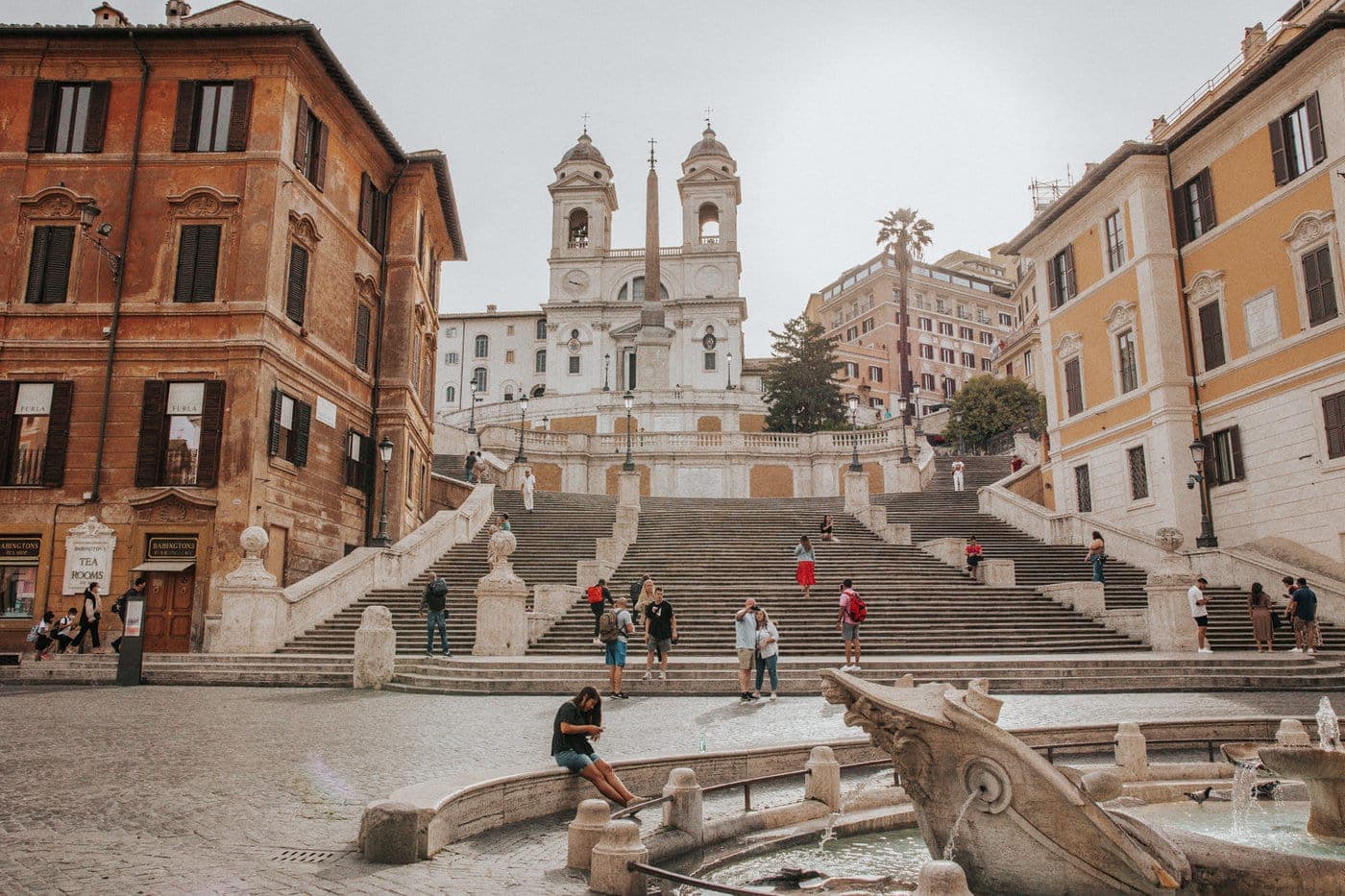
Business district
A short walk from the Spanish Steps around Piazza di Spagna is the most elegant business district. Today, you will find the most luxurious brands there, but it was also famous in the past and aristocratic travellers used to stop here. In the house of Romanticism, famous artists such as Keats, Byron, Balzac and Wagner headed here.
Piazza del Popolo
One of the most visited squares in Rome and the starting point for some of the main streets in the centre of Rome, today it is surrounded by cafes, shops, restaurants and hotels and is always lively. But this was not the case before. According to legend, the place was cursed, and even in 1100 the inhabitants demanded that it be subjected to an exorcism of the devil.
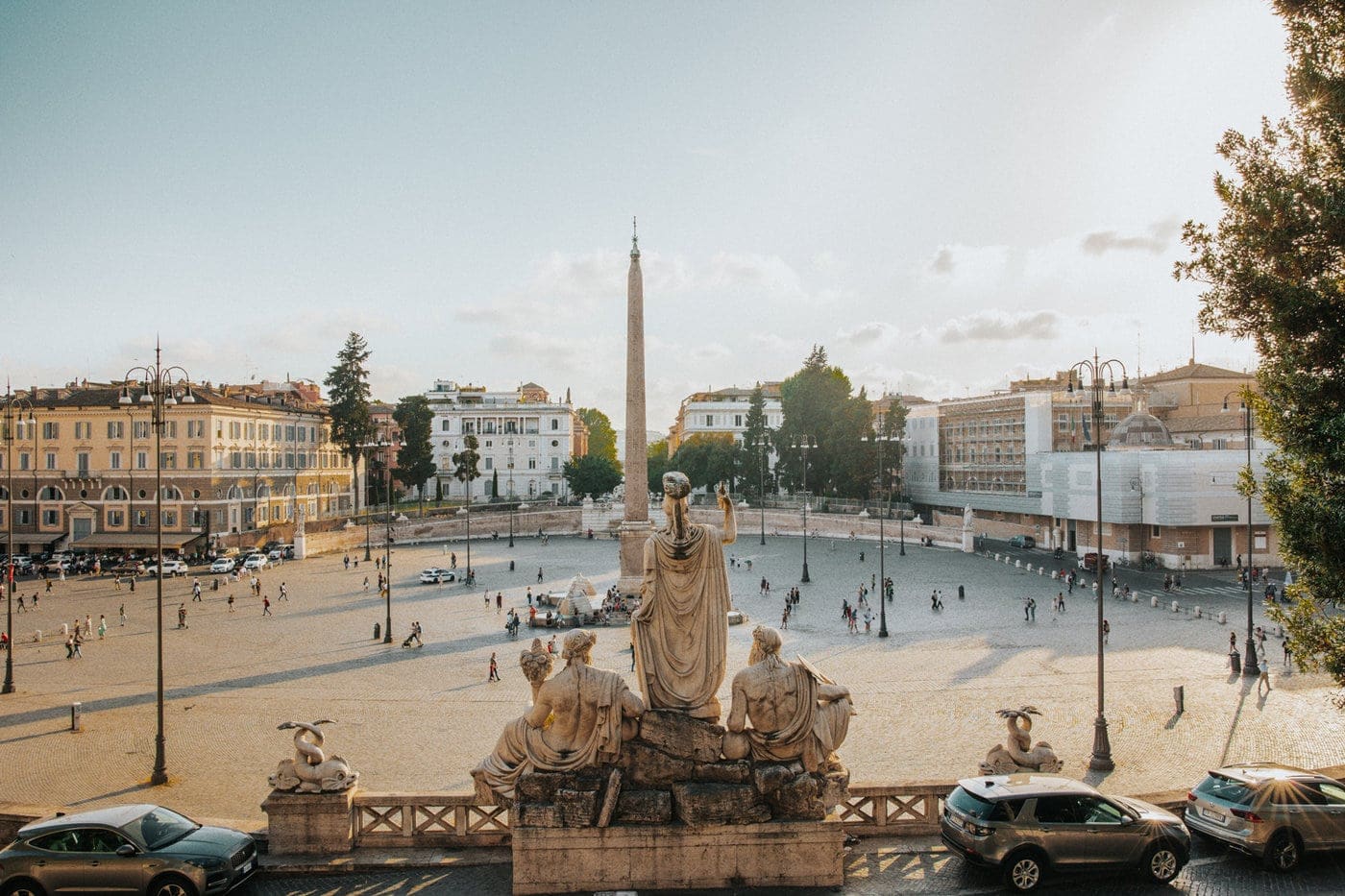
Pincian Gardens
To the east of Piazza del Popolo you will find the gardens. Climb up to the monumental rows of terraces, where you have a beautiful view of Piazza del Popolo and the surrounding area. The sunsets from here are also beautiful.
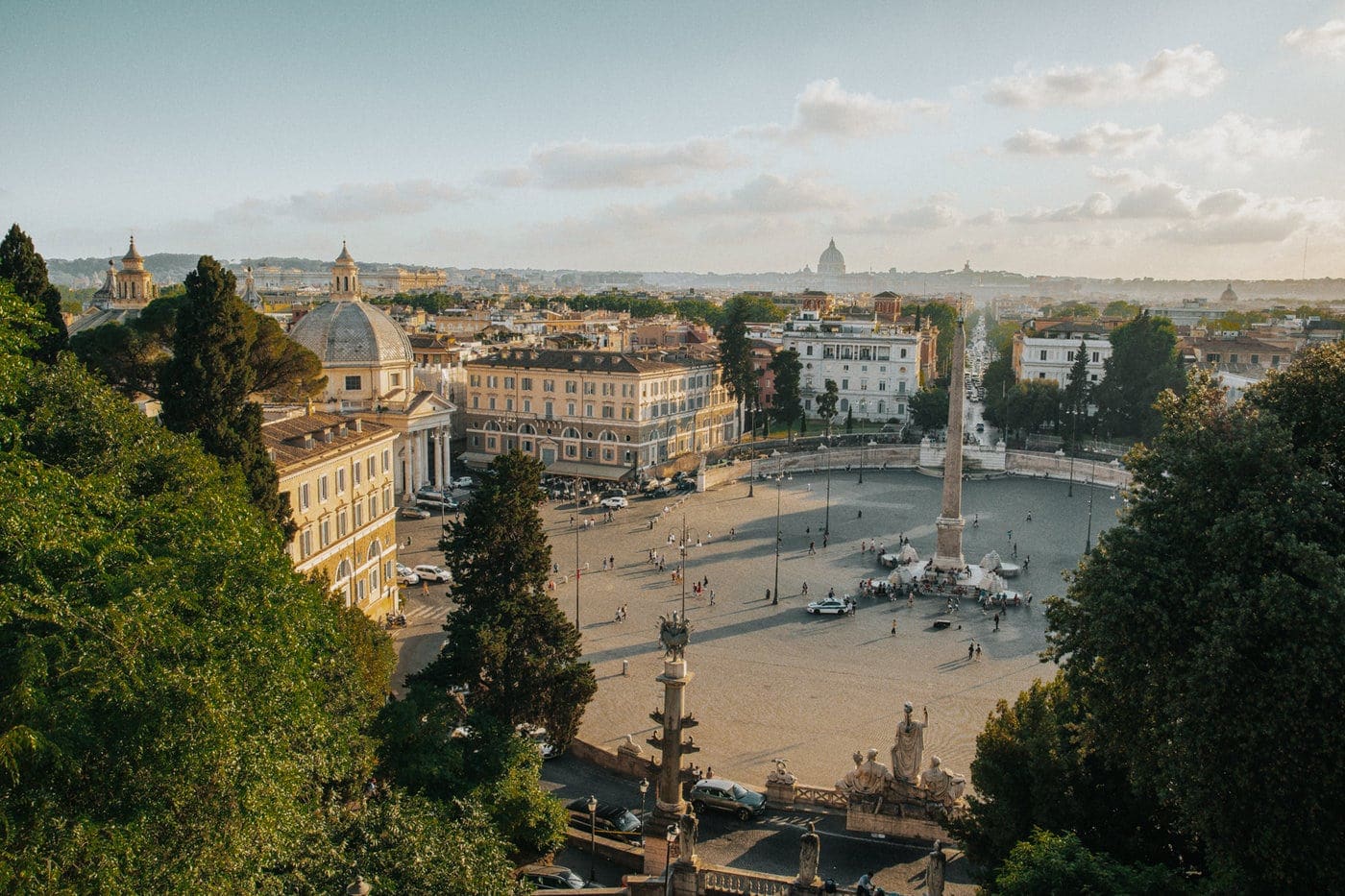
Villa Medici
If you walk along the Pincean promenade, you’ll reach the Villa Medici, built in 1564 and purchased by Napoleon for the French Academy in Rome, which is now home to young French artists who come to Rome on scholarships.
Villa Borghese
The Galleria Borghese is the perfect place to hide from the sun and rain, boasting valuable collections of Renaissance and Baroque art.
National Gallery (Galleria Nazionale d’Arte Moderna, abbreviated GNAM)
A short walk from Villa Borghese, the National Gallery houses the largest collection of modern art in Italy. Here you will see works of art by Van Gogh, Klimt and Cézanne.
The Mouth of Truth – Bocca della Verita
Another place made famous by the film Holiday in Rome: The Mouth of Truth. Weighing over a tonne, the marble mask of the face of a likely pagan god is now a very popular tourist attraction.
It is also the subject of many legends, the most popular of which, as heard in the film Holidays in Rome, says that it served as a lie detector. If the liar put his hand in the hole where his mouth was, it should have been bitten off.
Angel Castle
Castel Sant’Angelo is a monumental building with a rounded ground plan, which connects Rome and the Vatican with a wall. The castle was originally built as the mausoleum of Emperor Hadrian and over the years has served as a refuge for popes, but also as a prison where Giordano Bruno was imprisoned. At 13. century, a tunnel was built in it, which connected the castle with the Vatican.
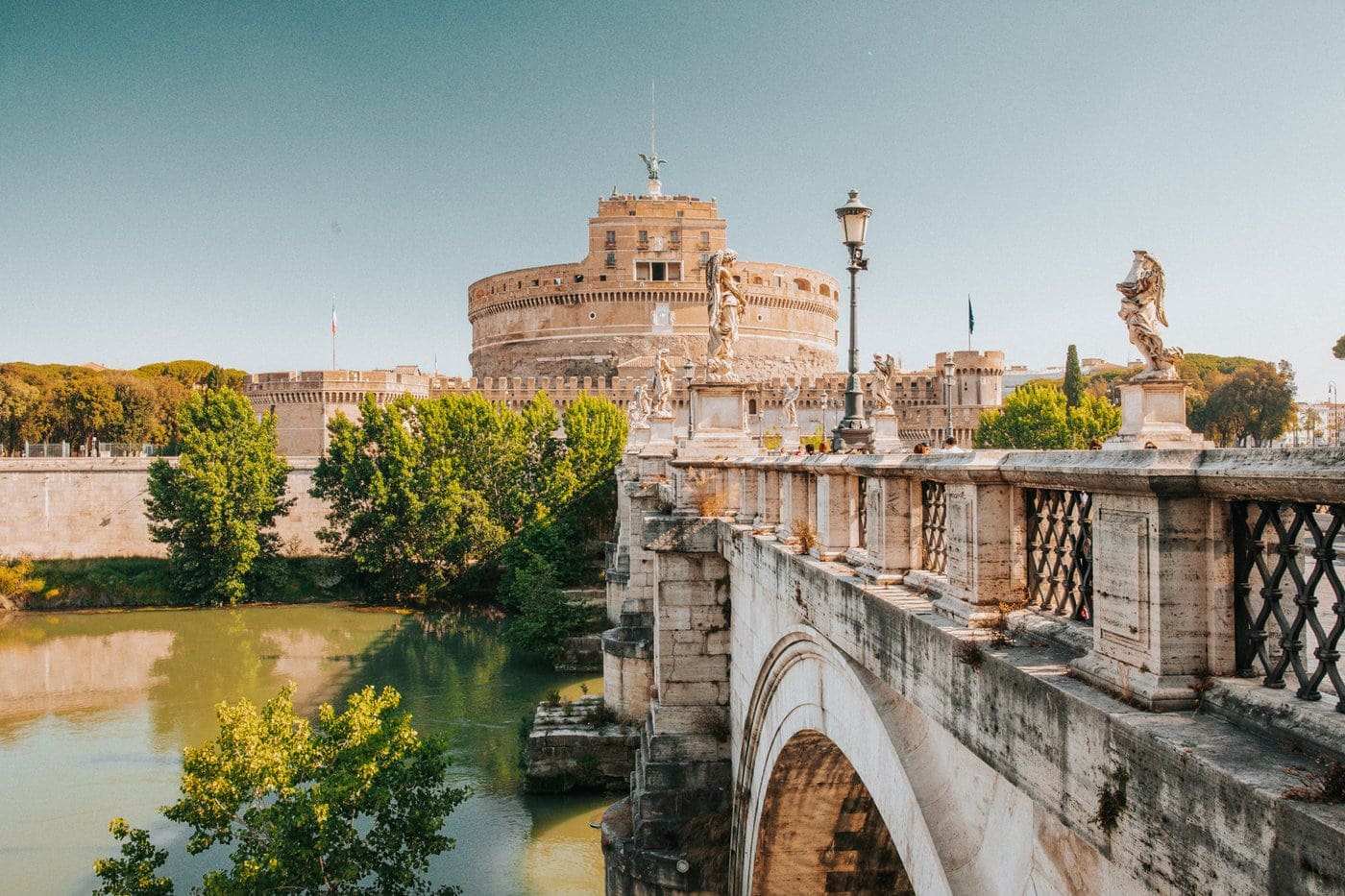
Vatican City
Set aside one full day for the Vatican and you won’t regret it. We recommend to come here first thing in the morning to avoid the biggest crowds.
The city-state of Vatican City, is a landlocked sovereign ecclesiastical city-state, an enclave within Rome, and with an area of approximately 49 hectares is the smallest state in the world. It has been ruled by the Pope all his life and is considered the centre of Christianity.
Basilica of St. Petra
The poet Goethe once reportedly said that to enter the Basilica of St. Peter is like entering eternity. During your visit, don’t miss the rather strenuous hike up to the dome of the Basilica of St. Peter’s Square, which offers one of the best views directly over St Peter’s Square and the Vatican Gardens.
Although we weren’t there on our last visit, I still remember that the actual climb up to the dome was very impressive as you walk through the interior, which was beautifully decorated. You have to climb a total of 551 steps.
St. Petra
If you go to the Vatican, St. You won’t miss Peter. What is certainly worth mentioning is that it can accommodate up to 400,000 people. A unique architectural masterpiece by Gian Lorenzo Bernini from 1656-1667, the centre of the square is dominated by a 331 ton obelisk, 25 metres high, decorated with two fountains from the 17th century. century, it has stood here since the reign of Emperor Caligula.
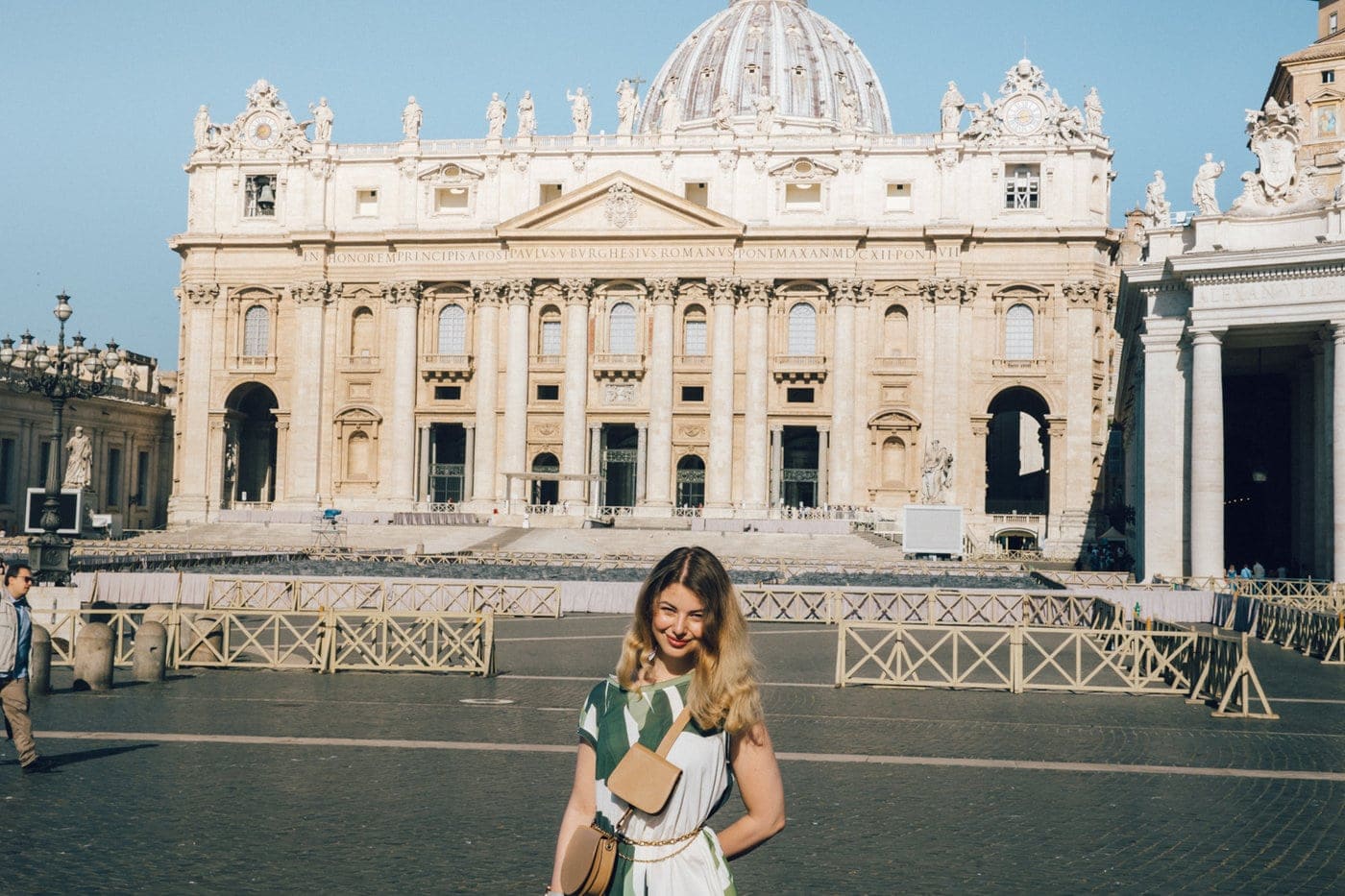
Vatican Museums
The Vatican Museums are visited by 6 million people a year, so with that in mind, be sure to buy your tickets in advance. The easiest way to buy it online is via Get Your Guide which is what we did. A number of people wrote to me on Instagram that you didn’t have tickets and spent several hours in a 35 degree queue. So avoid that.
We chose the afternoon hours, when we wanted to escape the heat. There is air conditioning in the Vatican Museums, but it didn’t run too much, so maybe it would have been better to go first thing in the morning.
The Vatican Museums have huge collections of artwork, we probably liked the rooms that were covered in maps and the Raffaello rooms the best. We opted for the audio-guided tour only and although we were determined to listen to everything at first, we soon found out that it was not in our power because we would have to spend about ten hours there.
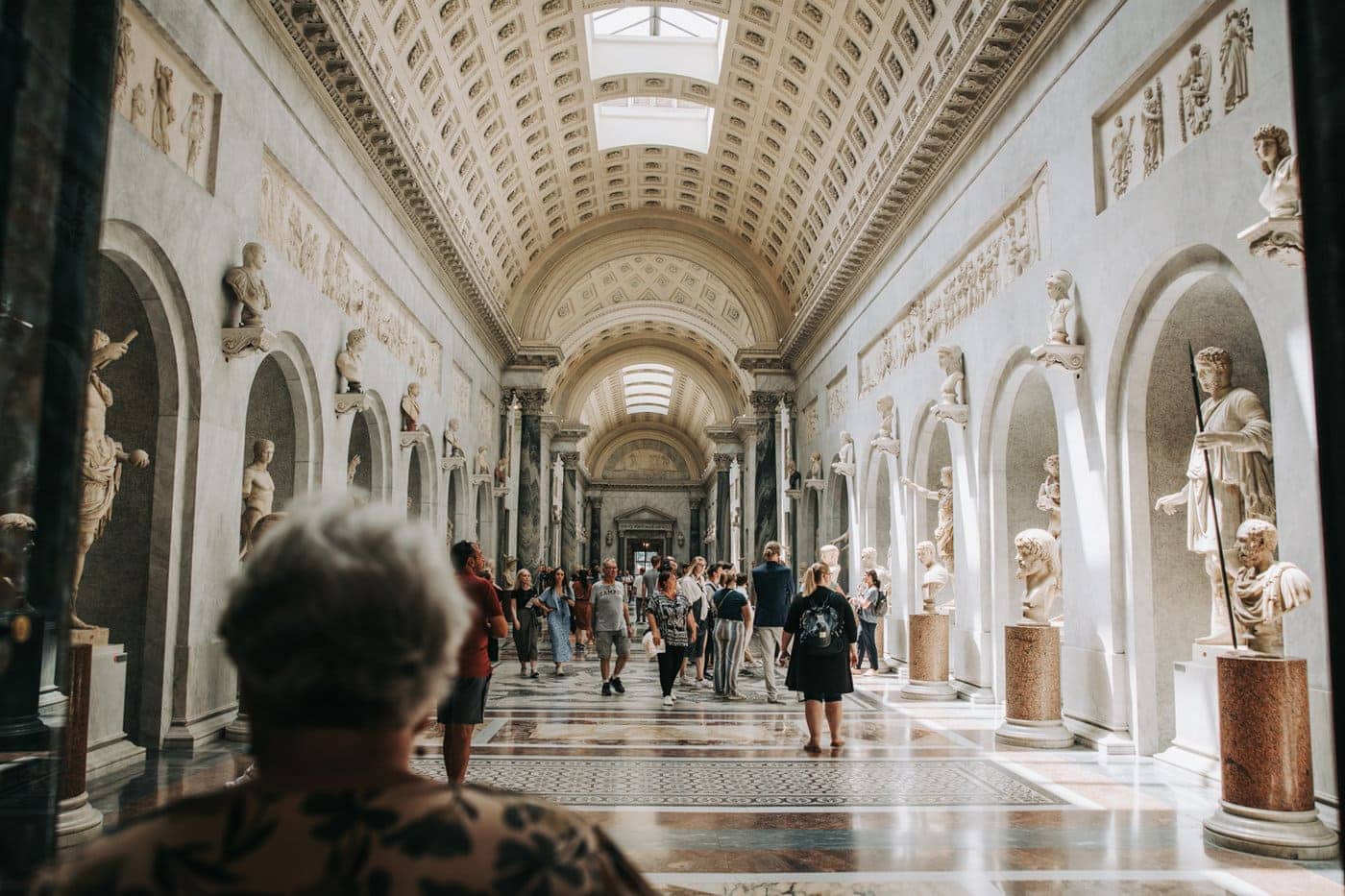
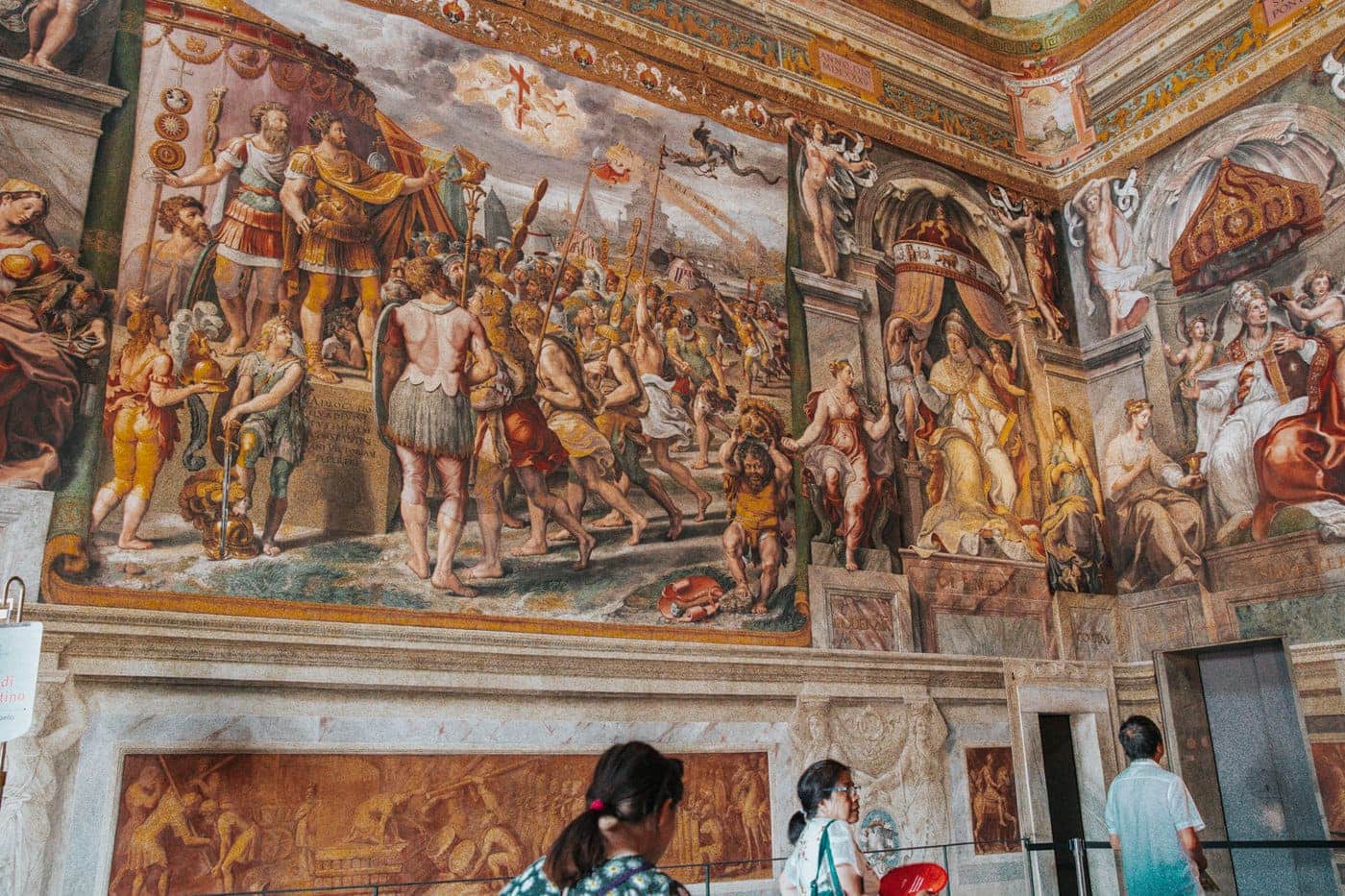
Sistine Chapel
It’s only accessible through the Vatican Museums, but if you’re only interested in those, you can buy an express ticket through Get Your Guide. The most famous frescoes on the vault are those by Michelangelo Buonarroti, who spent four years here, but if you love art like me, you will also notice the frescoes by Botticelli. There are also frescoes by Ghirlandaio, Perugini, and Rosselini.
You cannot take photographs in the Sistine Chapel.
What is the purpose of the Sistine Chapel? It is a chapel whose original main function is the assembly of the College of Cardinals, who meet here for special meetings and also hold the election of the Pope (conclave).
Caracalla Spa
If you’re a fan of archaeology, you can also visit the Baths of Carcall, built between 212 and 216 at the instigation of Emperor Marcus Aurelius, they became the largest and most lavish in the world at the time.
It’s fascinating what they contained. Caracalla’s spa had indoor and outdoor pools, a calidarium with hot water and eight saunas, and a frigidarium. The Frigidarium was a large and lavishly decorated basilica, with changing rooms, gymnasiums, libraries and even grocery stores.
Although you must imagine it today, back then they were magnificently decorated with frescoes, mosaics, statues and marble. There were stone tubs made of a single piece of granite or other mineral. In its heyday, Caracalla’s baths were resplendent with colour. Every single Roman, including women, could spend almost a whole day in the baths. It was the emperor’s gift to the Romans.
They are a bit off the traditional tourist routes, so they are not very popular.
Visit the Roman Catacombs
The Roman catacombs are a system of extensive underground burial grounds used since the 2nd century. to 5. century. At that time, Christians and Jews were not allowed to bury their dead in churches and cemeteries, so they built a vast labyrinth of passages. There are more than 60 catacombs under the city, only five are accessible:
- Catacombs of San Sebastiano,
- Catacombs of San Callisto,
- The Catacombs of Domitilla,
- Priscilla Catacombs,
- The Catacombs of Sant’Agnese.
Quirinal Palace
If you want to see where the President of Italy resides, you’ll find his residence in the Quirinal Palace. It is not Prague Castle, but it still stands out among Roman palaces.
It is the largest palace in the Italian capital, called Palazzo Quirinale in Italian, and stands on the square and hill of the same name.
Rome Itinerary: What to See in Rome in 4 Days
What to see in Rome in 4 days? We’ve put together a practical guide for your trip to Rome.
Day 1:
- Colosseum and Roman Forum – Start your trip by visiting the iconic Colosseum and the adjacent Roman Forum, where you can immerse yourself in the history of ancient Rome.
- Palatine Hill – Walk around Palatine Hill and enjoy the magnificent views.
- Trevi Fountain – In the evening, head to this famous fountain and don’t forget to toss a coin into it to ensure your return.
Day 2:
- Vatican – Explore the Vatican Museums, the Sistine Chapel, and St. Peter’s Basilica. However, we recommend booking tickets in advance.
- Castel Sant’Angelo – Walk to this fortified castle and enjoy the view of the Tiber.
- Piazza Navona – End the day in this beautiful square with fountains and cafes.
Day 3:
- Pantheon – Visit the Pantheon, one of the best-preserved ancient monuments.
- Campo de’ Fiori – Enjoy the market and discover local specialties.
- Trastevere – Stroll through this picturesque neighborhood and enjoy dinner in one of the traditional restaurants in the evening.
Day 4:
- Villa Borghese and its Gardens – Relax in this peaceful park and visit the Borghese Gallery.
- Spanish Steps – Walk up the steps and enjoy the atmosphere of this popular spot.
- Via del Corso – Take some time for shopping or have a coffee in the local cafes.
What to See in Rome in 3 Days
If you only have 3 days for Rome, then try this itinerary:
Day 1:
- Colosseum, Roman Forum, Palatine Hill.
- Trevi Fountain and an evening stroll through the city.
Day 2:
- Vatican Museums, Sistine Chapel, and St. Peter’s Basilica.
- Castel Sant’Angelo and Piazza Navona.
Day 3:
- Pantheon, Campo de’ Fiori, Trastevere.
- If you have time, visit the Spanish Steps or Villa Borghese.
What to See in Rome in 2 Days
In two days in Rome, you can also manage to see quite a bit; we recommend these places:
Day 1:
- Morning: Colosseum, Roman Forum, and Palatine Hill.
- Afternoon: Pantheon and Trevi Fountain.
- Evening: Dinner in Trastevere.
Day 2:
- Morning: Vatican Museums and St. Peter’s Basilica.
- Afternoon: Piazza Navona and Castel Sant’Angelo.
- Evening: Relax by the Spanish Steps or take a walk around Villa Borghese.
What to See in Rome in 1 Day
If you only have one day to visit Rome, it’s important to focus on the most iconic landmarks that will allow you to soak in the city’s atmosphere. This itinerary will help you cover the essentials:
Morning: Start at the Colosseum and Roman Forum
- Colosseum: One of Rome’s most famous symbols. We recommend purchasing tickets online to avoid queues.
- Roman Forum: After visiting the Colosseum, proceed to the Roman Forum, the historical center of ancient Rome, full of ruins and archaeological sites.
Tip: If you don’t have time for a detailed tour, simply admire the Colosseum from the outside and walk around the Roman Forum.
Noon: Walk to the Pantheon via Piazza Venezia
- Walk past Piazza Venezia and the Monument to Victor Emmanuel II, a massive structure that will impress you with its size.
- Continue on foot to the Pantheon, an ancient temple with a famous dome.
Lunch: Stop for lunch at one of the traditional Roman trattorias near the Pantheon. We recommend trying Carbonara or Cacio e Pepe pasta.
Afternoon: Trevi Fountain and Spanish Steps
- After lunch, head to the Trevi Fountain, where you can toss a coin and make a wish.
- Walk to the Spanish Steps in Piazza di Spagna. This iconic spot is great for a short break and photos.
Evening: End the day in the Vatican or at Castel Sant’Angelo
- If you have the energy, head to St. Peter’s Basilica Petra in the Vatican. Visiting the basilica is free, but it can be time-consuming.
- An alternative is a romantic stroll around Castel Sant’Angelo and along the Tiber River.
Tips for a quick day in Rome:
- Wear comfortable shoes – you’ll be doing a lot of walking.
- Buy tickets for the Colosseum and, if applicable, the Vatican in advance.
- Use our map with points of interest to easily navigate.
- If you have time left, enjoy Italian gelato in one of the squares, such as Piazza Navona.
Map with Points of Interest for your Phone
Save a map of the best places in Rome directly to your phone. After purchase, you will receive a link to a private Google Map, which you can save by clicking “Follow”. This will copy it to your Google account and display it on all devices where you use Google Maps.
FAQ
What is the best time to visit Rome?
The best time to visit Rome is spring (March to May) and autumn (September to November). The weather is pleasant, and you’ll avoid the largest tourist crowds. Summer months tend to be very hot and crowded.
What’s the best way to get around Rome?
We recommend getting around on foot, as most major attractions are close to each other. For longer distances, you can use the metro, buses, or trams. Taxis or apps like Uber are also an option.
Do I need tickets for attractions in advance?
Yes, we recommend booking tickets for the Colosseum, Vatican Museums, and other popular attractions online in advance to avoid long queues.
How many days are needed to explore Rome?
Ideally, at least 3–4 days are needed to see the main attractions and enjoy the city’s atmosphere. If you have less time, focus on the most important places, such as the Colosseum, Vatican, and Pantheon.
Is Rome safe?
Rome is generally a safe city, but be aware of pickpockets, especially in tourist areas and on public transport. Always keep your valuables close and secured in a purse or backpack.
What is the local cuisine like and what should I try?
Rome offers great cuisine. Be sure to try:
Cacio e pepe (pasta with pepper and cheese),
Carbonara,
Supplì (fried rice balls),
Gelato (traditional Italian ice cream),
Espresso or cappuccino.
Rome, Italy: 27 Best Things to Do and See
What to PackTake a look at our travel packing guide to help you prepare. Choose the right travel backpack, check out the travel gadgets and don’t forget anything important at home. Where to Find FlightsSearch for cheap airline tickets at Kiwi , they’re our favourite portal. Be sure to read our instructions how to get cheap airline tickets. Car RentalWe commonly use the comparison site RentalCars.com, which helps us choose a car provider. Accommodation BookingBooking.com is our most popular hotel search engine. We always compare hotels with local apartments and rooms on Airbnb ( 725 CZK discount ). Read, how we find cheap accommodation . Don’t Forget Travel InsuranceTravel insurance is an absolute must. For shorter journeys, choose AXA ( 50% discount ) and for longer journeys the British insurer True Traveller . Take a look at comparison of all insurance companies and choose the one that suits you best. |
Tips and Tricks for Your Vacation
Don’t Overpay for Flights
Search for flights on Kayak. It’s our favorite search engine because it scans the websites of all airlines and always finds the cheapest connection.
Book Your Accommodation Smartly
The best experiences we’ve had when looking for accommodation (from Alaska to Morocco) are with Booking.com, where hotels, apartments, and entire houses are usually the cheapest and most widely available.
Don’t Forget Travel Insurance
Good travel insurance will protect you against illness, accidents, theft, or flight cancellations. We’ve had a few hospital visits abroad, so we know how important it is to have proper insurance arranged.
Where we insure ourselves: SafetyWing (best for everyone) and TrueTraveller (for extra-long trips).
Why don’t we recommend any Czech insurance company? Because they have too many restrictions. They set limits on the number of days abroad, travel insurance via a credit card often requires you to pay medical expenses only with that card, and they frequently limit the number of returns to the Czech Republic.
Find the Best Experiences
Get Your Guide is a huge online marketplace where you can book guided walks, trips, skip-the-line tickets, tours, and much more. We always find some extra fun there!
